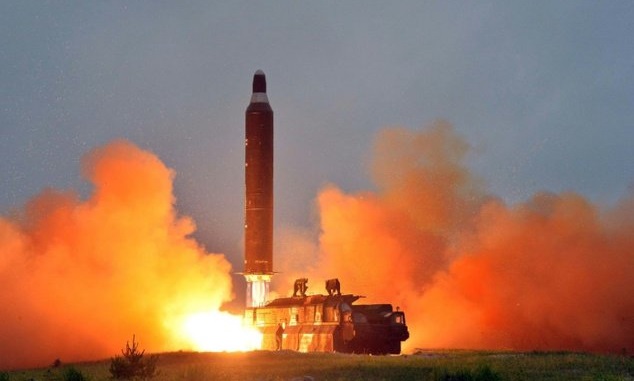
Seoul, South Korea | AFP | North Korea Thursday released pictures of its latest missile launch, giving analysts a chance to test Pyongyang’s claim of a breakthrough that brings the whole of the US within range of a nuclear strike.
Leader Kim Jong-Un declared the test of a Hwasong-15 intercontinental ballistic missile (ICBM) had completed his nation’s drive to become a full-fledged nuclear power.
But analysts remain unconvinced that the North has mastered the technology required to launch and direct a missile, and ensure it survives the difficult re-entry into the Earth’s atmosphere.
“Though North Korea continues to progress, our assessments have not changed in that a viable ICBM capable of reaching the west coast of the US mainland still remains about a year away,” said the respected 38North website.
Here are some key issues raised by the launch, and what Pyongyang — and the outside world — say about them.
– Range –
PYONGYANG: The Hwasong-15 reached an altitude of 4,475 kilometres (2,780 miles) before splashing into the sea 950 kilometres east of its launch site.
“The ICBM Hwasong-15 type weaponry system…is capable of striking the whole mainland of the US.”
ANALYSTS: The numbers indicate that if this missile flew on a standard path instead of a lofted test trajectory, it would have a range of more than 13,000 kilometres, said David Wright, co-director and senior scientist at the Union of Concerned Scientists.
“Such a missile would have more than enough range to reach… any part of the continental United States,” Wright said.
– Reliability –
PYONGYANG: The Hwasong-15 can carry a “super-large heavy warhead” and deliver its load on target.
“After making a 53-minute flight along its preset orbit, the rocket accurately landed in the target waters set.
“The accuracy of hitting targets by posture control and speed correction in the mid-flight section, accuracy in operation of high-thrust engine… was confirmed.”
The rocket was launched from a new home-made, nine-axle vehicle that is bigger than any launch vehicle previously employed.
ANALYSTS: Scott Lafoy, an analyst at NKNews said the delivery vehicle appeared to be transporter erector (T/E), which is able to both move the missile into place and to lift it upright.
“This means that this vehicle pulls up to a specific piece of infrastructure, erects the missile, detaches from the firing table, and leaves,” he said.
This makes it a relatively lengthy process.
“Since the US and (South Korea) are focused on precision, snap responses, this makes a big difference during crises.”
In terms of payload — North Korea is hinting at a nuclear device with the words “super-large heavy warhead” — David Wright was sceptical.
“Given the increase in range it seems likely that it carried a very light mock warhead. If true, that means it would be incapable of carrying a nuclear warhead to this long distance, since such a warhead would be much heavier.”
– Re-entry –
PYONGYANG: The North has previously claimed to have mastered the tricky technology necessary to protect a warhead from the high temperatures encountered as the missile hurtles back to Earth from space.
Wednesday’s test proved that again.
“The test-fire also re-confirmed the control and stabilization technology, phase-separation and start-up technology and the safety of warhead in the atmospheric reentry environment that had already been confirmed.”
ANALYSTS: Observers note the new missile’s nose was rounded, unlike the sharp tips of the two Hwasong-14 ICBMs the North tested in July, indicating efforts to master re-entry technology.
But a US official, speaking on condition of anonymity, told AFP that the Hwasong-15 went up and down very steeply, so would not have encountered the same atmospheric friction as that on a lower, more regular, arc.
Michael Elleman of the International Institute for Strategic Studies agreed: “Many more tests are needed to establish the missile’s performance and reliability, and it remains unclear if the North’s engineers have attempted to validate the efficacy of the missile’s re-entry vehicle.”
 The Independent Uganda: You get the Truth we Pay the Price
The Independent Uganda: You get the Truth we Pay the Price



